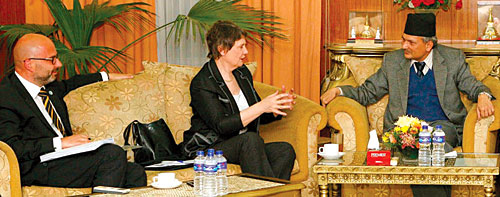 BIKRAM RAI |
Helen Clark, Administrator of the United Nations Development Programme (UNDP) and former prime minister of New Zealand is in Nepal this week to inspect development projects. Clark spoke to Nepali Times about Nepal's progress in meeting Millennium Development Goals and the challenges ahead.
Nepali Times: With only four years to go for the MDG target date, how would you rate the chances of developing countries to meet the goals?
Helen Clark: Over the past decade, notable progress has been made on each individual MDG, including in many least developed countries and under very challenging circumstances. Business as usual, however, won't get the world all the way to achieve the MDG targets. The right mix of policies, targeted technical assistance, institutional capacity, adequate funding, and strong political commitment are necessary to accelerate progress. UNDP supports country-led development based on inclusive growth strategies which benefit the poorest and most vulnerable.
And how does Nepal's performance compare with the others?
Despite political and economic challenges, Nepal has made MDG progress over the past decade. According to the 2010 MDG progress report, Nepal is on track to achieve most targets, with a few exceptions, if the current trends in progress continue. Achievements in reducing child mortality and improving maternal health are particularly encouraging. Poverty has gone down significantly, and Nepal is close to reaching the 2015 MDG poverty target. Nepal has already achieved gender parity in primary school enrollments, but the gender gap remains high at secondary and tertiary education levels. As a former political leader in my own country, I am particularly happy to note that one-third of the seats in the Constituent Assembly are now held by women. Nepal has had the foresight to integrate the MDGs into its national development strategies, as reflected in its Three Year Plan, and I have confidence that Nepal will continue its MDG progress.
A lot of the problems in the developing world need long-term structural and governance solutions, but aren't the needs are so immediate.
Development is a long term process. UNDP works for decades in countries and helps them build the capacity to lift human development. Some face greater challenges than others, but all can succeed. It is important to align meeting short term needs with the longer term direction established, in other words, each step taken should be in support of the goals to be achieved over time.
UN staff were among the thousands who died in the Haiti earthquake last year. What lessons has the UN learnt about disaster preparedness and response from that event?
Haiti was a tragic reminder of the importance of building resilience to disaster. Disaster risk reduction measures, ensuring that humanitarian response systems are ready, and imagining the unimaginable all need to be undertaken. Effective governance is needed to achieve this, of the kind which ensures building codes are in place and enforced, land use plans are carefully thought through, and creates a clear sense of duty of care among elected and appointed public officials. International support is needed for both the humanitarian and development aspects of this work.
Any particular effect this has had in helping Nepal prepare for a disaster that one day is sure to come?
Given the high earthquake risk and other hazards in Nepal, UNDP has been working with the government on disaster risk reduction for many years. A recent result of that work was the establishment with the Home Ministry of a National Emergency Operations Centre (NEOC). We already see concrete results: when an earthquake struck the east of Nepal recently, the national and district level emergency operation centres reacted within one hour. That was a huge improvement compared to the level of preparedness only one year ago. UNDP and a range of partners also helped the government develop a new National Strategy for Disaster Risk Management which was approved in 2009. It signals an important shift in policy from focusing mainly on relief and response to a more balanced approach to risk reduction overall. The key challenge now is to implement this ambitious new strategy with a sense of urgency
A Nepal Risk Reduction Consortium came into being in 2009 under government leadership, bringing together the UN system, the World Bank and the Asian Development Bank, the Red Cross Movement, the European Commission, and the governments of the United Kingdom, the United States of America, and Australia, to accelerate and expand risk reduction measures in Nepal. The Consortium has already raised more than $60 million for school and hospital retrofitting, emergency preparedness, building code enforcement, community preparedness, and many other measures. The Consortium is seen as a model of how to get organised to tackle disaster risk more effectively in countries like Nepal.
And, finally, impressions of your visit to Nepal this week?
We were very proud to have with us Crown Prince Haakon of Norway, who is the UNDP Goodwill Ambassador with us on our trip to Nepal this week. We have very vivid impressions of our visit here. It is an imposing landscape, and a challenge in development. We met the highest leaders in Kathmandu to women starting their own micro businesses in a village in western Nepal. It was very inspiring to see how much they could do with so little, and how giving young people skills can better the livelihoods of their families. In our visit to a maternity clinic we saw the role played by Nepal's female health volunteers and what was most significant to me was that that it was an example of a community that could articulate what they wanted from local leaders, and they said they wanted better maternity clinics. Back in Kathmandu we had two very significant meetings on Weaddnesday, one with CA members and a meeting with senior political leaders at the Prime minister's residence. It is enormously significant that they take the job of speedily completing the peace and constitution process seriously.
Read also:
Why to be more equal


